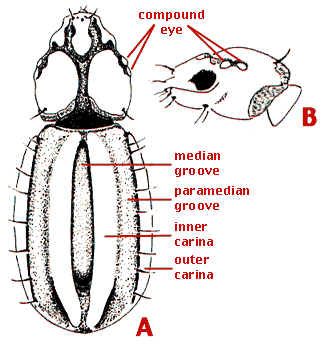Rhyzodiastes (Rhyzotetrops)
Rhyzodiastes janus
Ross T. BellCharacteristics
Each compound eye is divided into two well-separated, ocellus-like structures, one anterior to the other. This remarkable four-eyed condition is duplicated in Clinidium (s. str.) beccarii and related species.


Rhyzodiastes (Rhyzotetrops) janus.
(A) Dorsal aspect of head and pronotum. (B) Head (lateral aspect).
Modified from Bell and Bell (1985). Copyright © 1985 Ross T. Bell and Joyce R. Bell.
The elytron has an intercalary stria. The apical stylet of the antenna is acuminate. The antennal tufts are limited to segments VII-X. The clypeal setae are present. The median groove of the pronotum is strongly dilated. The inner carinae slope gradually into the paramedian grooves, which are glabrous except for a strip of pollinosity along the medial margin of the outer carina. This margin is curved and of even width, and it carries a row of setae. The intra-tubercular stria is obsolete except for the apex, which is impressed. All femora have many long setae.
References
Bell, R. T. and J. R. Bell. 1985. Rhysodini of the World Part IV. Revisions of Rhyzodiastes and Clinidium, with new species in other genera (Coleoptera: Carabidae or Rhysodidae). Quaestiones Entomologicae 21(1): 1-172.
About This Page
Ross T. Bell

University of Vermont, Burlington, Vermont, USA
Page copyright © 2000 Ross T. Bell
All Rights Reserved.
- First online 01 March 2000
Citing this page:
Bell, Ross T. 2000. Rhyzodiastes (Rhyzotetrops). Rhyzodiastes janus. Version 01 March 2000 (under construction). http://tolweb.org/Rhyzodiastes_janus/1931/2000.03.01 in The Tree of Life Web Project, http://tolweb.org/






 Go to quick links
Go to quick search
Go to navigation for this section of the ToL site
Go to detailed links for the ToL site
Go to quick links
Go to quick search
Go to navigation for this section of the ToL site
Go to detailed links for the ToL site